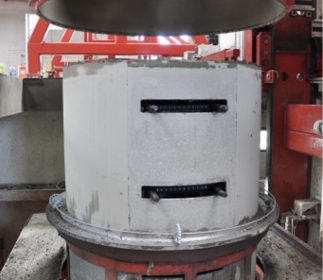CalPortland lifts Concrete Products business
|
|
| PHOTOS: Concrete Products, Prinzing-Pfeiffer |
 |
| The new machinery eases product molding with cast-in step inserts; the SCP-branded steps are inserted as product curing begins. CalPortland Concrete Products® underscores the long term, field safety aspect of steel-reinforced, copolymer propylene steps firmly secured to cast-in inserts. |
CalPortland Concrete Products® launched as Southwest Concrete Products (SCP) in the mid-1960s, a good period for entrepreneurs promoting precast methods as an economical alternative to the laborious practice of building manhole and vertical underground structures with clay or concrete brick. Located in Ontario, Calif., near the middle of the Los Angeles to Inland Empire sprawl, the company spent its first two decades establishing a strong brand in wet cast products.
SCP management approached the mid-1980s determined to maintain a lead in manhole production, and ushered dry cast drainage or utility structures into the market with the help of a Prinzing Mistral 150/250 machine from Germany. Population growth and infrastructure upgrades throughout southern California were easily driving demand to match dry cast machinery output.
The equipment performed dutifully in the 36- to 60-in. diameter product range for 30-plus years, more than half under the ownership of CalPortland Co. ®, based in nearby Glendora, Calif. A nod from the parent company enabled CalPortland Concrete Products to elevate safety, efficiency, quality and material optimization with the late-2017 installation of a new Mistral 150/250 automatic pipe and manhole machine from Prinzing-Pfeiffer, a member of Germany’s Topwerk Group.
The current generation machine fits the original equipment footprint, but required negligible vibration pit modification, and operates in tandem with new Prinzing-Pfeiffer automatic base pallet feeder and hoop welding models. The Mistral 150/250 has set up access from three sides, allowing optional base ring and molded product handling systems. It fabricates 36- to 60-in. diameter manhole or companion structures in lengths to 8 feet. Among its advanced features or processes are GEBA, which ensures precise product length, and step feeding system, which integrates the consolidation of plastic and galvanized steps into an automatic process. Pit placement of a central vibrator reduces machine noise levels, while Prinzing-Pfeiffer vibration technology imparts uniform concrete compaction and bughole-free surfaces.
The charter machine cast vertical structures with conventional reinforcing cages, fabricated on automated Apilion welding equipment CalPortland Concrete Products now uses for large, wet cast structures. Most new Mistral 150/250 product has horizontal reinforcement only: Steel hoops of uniform diameter on manhole bases and risers, and varying diameter for cones. Secured with circular plastic chairs, the hoops are placed manually on base rings and at specified mold core points. Forms are then lowered into the pit, filled with zero slump mixes, pressed and compacted.
The switch from cages to hoops equates to significant steel savings and lower energy consumption rooted in curtailed welding processes. The reinforcing steel-optimized structures, nevertheless, meet performance requirements of ASTM C478-18 Standard Specification for Circular Precast Reinforced Concrete Manhole Sections.
Measured against the legacy machine’s manual method tendencies, the Prinzing-Pfeiffer Mistral 150/250 brings new fabricating efficiency to manhole bases, risers and cones with cast-in steps. Production crews can place SCP-brand manhole step inserts concurrent with the reinforcing hoops. Robust molding and compaction of product walls secure the inserts to a level whereby steps would require chiseling or hydrodemolition to pull out. Crews install press-fit steps—injection-molded, copolymer propylene with a center core of ½-in. steel reinforcement—after base, riser or cone units are transferred from the machine platform to the curing chamber.
 |
| CalPortland® Concrete Products casts manholes, risers and cones with the new generation Mistral 150/250, a versatile machine that can also handle conventional concrete pipe plus rectangular or square boxes. Installed adjacent to a pit, the machine comprises a press with top vibration, outer mold, mold core, frequency controlled central vibrator with quick-change clamping, and automatic concrete feeding system. After a base pallet or ring is shifted over the mold core, the outer mold is positioned and the entire platform lowered. The hopper feeds mixes to a spreader that charges the mold, then retreats to make way for the press. The Ontario machinery is set to run on two- to six-minute cycles; de-molded product is transferred by forklift truck, although Prinzing-Pfeiffer can equip the Mistral 150/250 with factory-supplied shifter, ratchet feeder, carrying device or robotic cranes. |
 
|
 |
| The automatic hoop-welding Apilion PP HWM-S system consists of a wire spool and straightener; hoop templates of varying diameter; wire feeding, cutting, welding and cooling devices; plus transfer to a portable collection rack. The replacement of cages with hoops in dry cast products sharply lowers Ontario plant steel requirements. |
  |
INVESTMENT CYCLE
 |
| Like peer operators that started with a narrow range of small products, CalPortland® Concrete Products has built an inventory of progressively larger underground or utility offerings representing better solutions to cast-in-place concrete, brick, block or plastic alternatives. |
 |
| The new Prinzing-Pfeiffer Mistral machine is the centerpiece of the CalPortland Concrete Products operation, which also harbors a small dry cast ring machine and an array of formwork for standard or licensed product. The latter include Redi-Rock International’s retaining walls (above and below) plus the newer Pole Base product, whose ease of delivery and placement is reflected in traction from developers and contractors unaccustomed to a precast alternative to cast-in-place foundations and decorative enclosure of lower lighting structure sections. |
 |
